 \\
\\Emerald Dragon
During the 16-bit era, it was a difficult time for fans of JRPGs. Western releases were very inconsistent during this time. Magazine articles would have people salivating over all of the different games coming out in Japan. All one could do was hope and pray that at least a few of these would get translated into English.It was a coin toss whether this would happen or not, though. Even big name series like Final Fantasy and Dragon Quest had no guarantee of a Western release at that time. During the heyday of the SNES, not a single Dragon Quest came to the system outside of Japan. Meanwhile, Final Fantasy V suffered the same fate. Publishers of JRPGs just weren't convinced that there was a big enough market in North America for them to bother with translating their games. Those were some dark times.
Thankfully, as the years passed, fan translations of some of these games began to emerge, and today we have the opportunity to experience several games from this period that never received an official release outside of Japan. One such game, and the one we will be looking at in this article, is Emerald Dragon for the Super Famicom.
This game was developed by a studio named Glodia, which was a small company that largely focused on RPGs for popular computers in Japan. They developed and published a number of games mostly for the PC-88, PC-98, and FM Towns from the mid 1980s to the mid 1990s. Emerald Dragon was actually the only time one of their games was ported to the Super Famicom. It was very rare for Glodia's games to appear on consoles.
The game is fairly typical fantasy fare, but what it does it does well. The story begins with a small settlement of dragons witnessing a sailing ship sink off their shores. When they go to investigate, they find only one survivor, a small girl with amnesia named Tamryn. The dragons happily took her in and raised her as one of their own. While she was with them, Tamryn became close friends with a dragon boy named Atrushan. After several years, Tamryn decided it was finally time for her to return to the human world to try and figure out her past. Before she sets off, Atrushan breaks off one of his horns and gives it to her. He then tells her to blow on it if she ever needs help and he will come to her aide. Yet more time passes, and then one day Atrushan hears the call of the horn. After a brief discussion with the elder dragons, and a ceremony that turns Atrushan into a human so he can survive in the human world, he sets off and the game begins.
From there, it's a straightforward quest to save the world from an evil empire. There's nothing out of the ordinary about the story, but the large cast of enjoyable characters go a long way in bringing it to life. In a lot of ways, Emerald Dragon's story feels like it's in the same vein as Record of Lodoss War: it's firmly entrenched in the realm of fantasy role-playing, and embraces it wholeheartedly. In the end, it's a very character-driven story. There's even a party chat option where characters can talk among themselves. Some of this is banter, while they also remind the player what they need to do next. The feature doesn't bring anything gameplay-wise like, say, Star Ocean's party interaction system, but it does add a bit of additional color to the experience.
Visually, the game is fairly simplistic in terms of its presentation. There isn't a huge amount of detail in the characters, enemies, or environments. However, there are several little animations that bring a lot of life to the characters. The game has quite a few in-game cut scenes to advance the story. During these, the characters have a number of additional little animations that bring a lot of charm to the game. Major characters also have nice portraits that appear alongside their dialogue that look quite nice. They're drawn in a style that was very popular in Japan during the late 80s and early 90s, so fans of that era of anime have something to look forward to.
With regards to the game's soundtrack, it is quite well done. There are a lot of memorable tracks throughout the game. A nice touch that was included is that there are little bits of music that pop up when something major happens in the story to add weight to the situation. They're basically little melodramatic ba-ba-ba~s but they work suprisingly well.
While what has been looked at thus far has been fairly standard for the genre during the time when Emerald Dragon came out, it did try to do something a little bit different with its battles. When a fight starts, all participants take the field with the party positioned at the bottom of the screen and enemies at the top. From there, players will notice that each character and enemy has a gauge at the top of the screen. This represents how many actions they can take each turn. Movement slowly depletes the gauge, as does attacking and casting spells. Oddly, using items has no effect on it. When the gauge is nearly empty, it turns red. During this time any attack done will be much weaker, so it's usually better to choose defending one's self when that happens. It's an interesting approach to battles that really wasn't something one saw in JRPGs during this time. As enjoyable as the battles are, though, they are held back by the fact that players can only control Atrushan. All other characters are operated by the game's AI, which can sometimes lead to questionable decision making.
While Emerald Dragon is certainly an enjoyable RPG on the SNES, it's interesting to note that many consider it to be the least good version of the game. Concensus is that the computer versions of the game are far superior because the SFC port had to be trimmed down in a number of ways. For one, the port had a traditional overworld map where Atrushan's party would march around and when they got near a town or castle, players would see a small icon of the place that they would walk over and be warped into. Versions of the game released on personal computers had a seamless world by comparison. So, while walking in a field, players may slowly see buildings and villagers scroll in on the side of the screen as they continue moving, then suddenly they've walked into a settlement.
The SFC version of the game is also by far the easiest. Every character was given massive buffs to their HP and attack power for this version of the game. For comparison, by the time one fights the final boss in the PC-98 version of Emerald Dragon, Atrushan will have around 500 or 600 HP. Meanwhile, he'll have more like 5,000 or 6,000 HP in the SFC version, while hitting like a truck as he inflicts 1-2K damage on the boss with each swing of his sword.
Moreover, the SFC version has a bottomless inventory, so players can carry virtually limitless supplies for all intents and purposes, which makes a lot of battles much easier. The SFC version also allows Atrushan to transform into a dragon once per battle, and it's an extremely overpowered feature which can trivialize most fights in the game. A number of side quests have also been removed and the SFC version of the game has much more powerful weapons strewn about in treasure chests that are easy to find. Compared to the other versions of Emerald Dragon, the SFC port is a cakewalk.
Despite the extreme ease in finishing the game, it's still very much a worthwhile experience. The story is just so well done that it makes Emerald Dragon worth spending time with. It has so many memorable, likeable characters that endear themselves to players. Moreover, the little touches of 80s anime art design and character animations add a lot of charm to the game. There are a lot of SFC RPGs that never left Japan, but more and more of them are receiving fan translations. People looking to explore these may want to consider hopping into Emerald Dragon. It's certainly one of the more enjoyable entries to be translated thus far.
- IroIro
March 14, 2019
Genre: Role-Playing Game
Developer: Glodia / Alfa System
Publisher: MediaWorks
Released: July 28, 1995
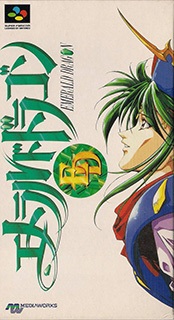
Emerald Dragon SFC Box Art
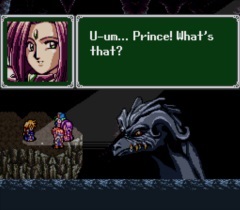
Meeting the Silver Dragon

The battle screen
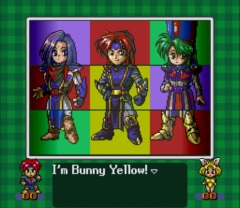
One of the gambling mini-games
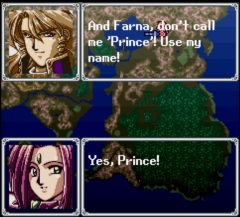
Party chat screen and world map
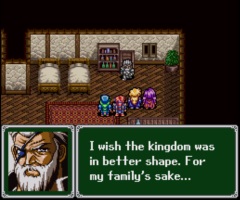
The story has a Record of Lodoss War feel to it